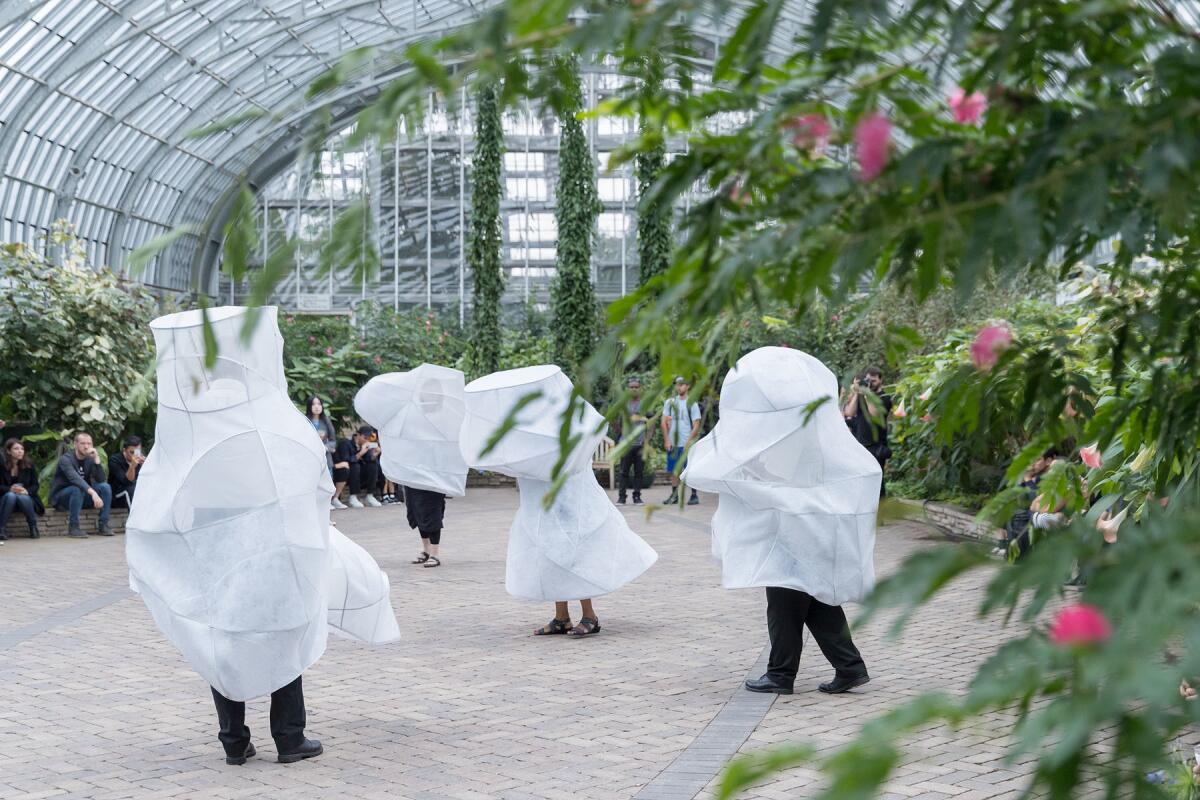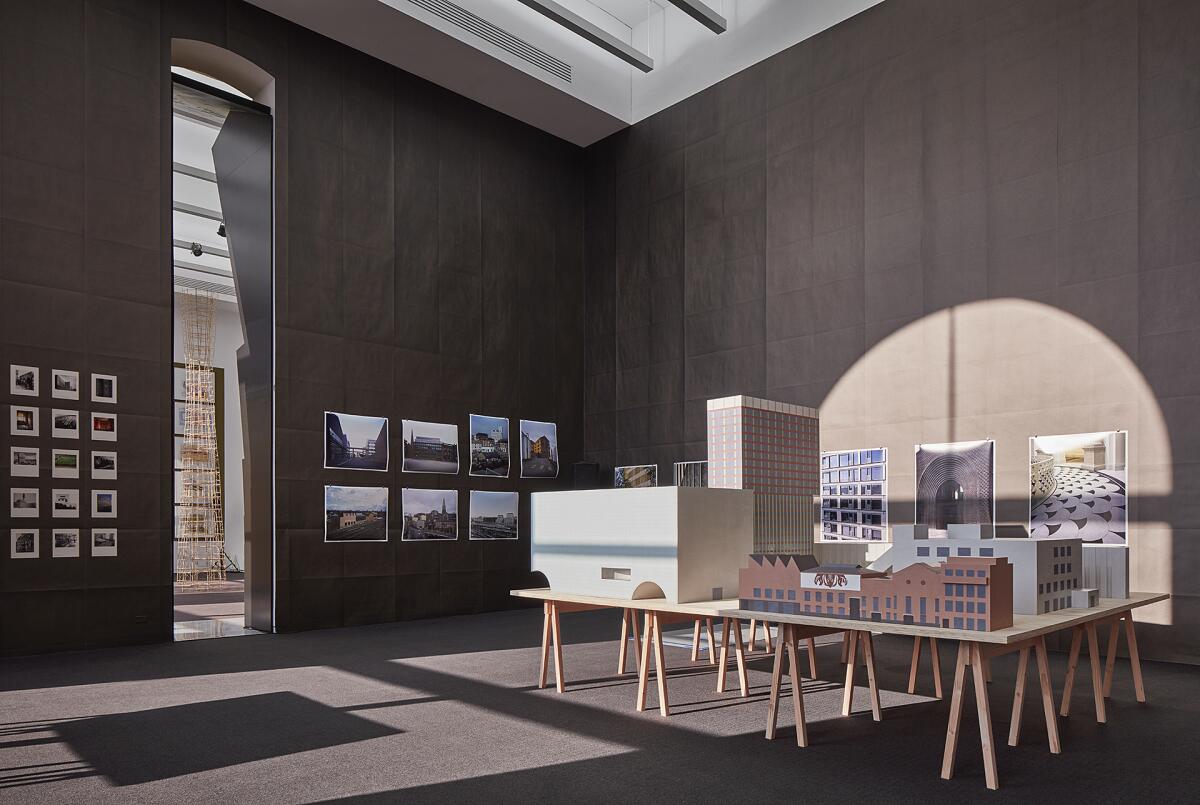Review: ‘Make New History,’ the second Chicago Architecture Biennial, brings the focus back to square one
- Share via
Architecture has taken an extrospective turn in recent years, looking outside itself for new ideas and to measure its progress. Or maybe just to feel more useful in a world flooding, burning and generally coming apart at the seams. Among its most visible and lauded figures have been dedicated populists like Chile’s Alejandro Aravena. It has made engagement — political, humanitarian and environmental — a key priority.
“Make New History,” the second edition of the Chicago Architecture Biennial, shifts the focus back inward. This elegant and densely layered exhibition, organized by the Los Angeles architects Sharon Johnston and Mark Lee, argues that architecture can (and should) find the motivation for new work within the discipline itself, within its own stores of self-knowledge and tradition.
As the title suggests, “Make New History” takes as its explicit theme the return to the past, to architectural precedent, that’s increasingly a touchstone for younger architects. It’s true that emerging and midcareer firms are these days producing work that’s grounded in history — and even prehistory, with buildings that look less neoclassical than primitive or primordial — to a degree not seen since the 1970s and ’80s.
Yet history shares top billing in this biennial with the argument Johnston and Lee want to make about architects and self-reliance, about a return to architectural first principles. The exhibition is as much about archetypes as history per se; it’s a portrait of a profession that — as Anna Neimark, of the L.A. firm First Office, put it during one of many opening-weekend panels — is “not pushing boundaries” but instead “coming back to the center” after recent dalliances with global capital, can-you-top-this form-making and work in service of political and ecological causes.
Each of those muses, the show suggests, drew architecture dangerously far from itself, diluting its power and chipping away at its autonomy. To underscore that point — and it’s telling that this quietly polemical biennial gets its message across as much by what it leaves out as what it includes — the exhibition features very few screens and even fewer renderings of expensive, formally adventurous new projects or statistics charting the various crises, planetary and otherwise, that architecture might be enlisted to tackle.
In place of the earnestness that has marked so many architecture shows in recent years, their save-the-world drive, this one is cerebral, well-tailored and faintly ironic. It's also post-digital, reflecting widespread fatigue with an architecture of flamboyant pixelated solutions.
The show’s awkward home base is again the Chicago Cultural Center, across Michigan Avenue from Millennium Park. Johnston and Lee deal at least as well with the building’s limitations and idiosyncrasies as the directors of the inaugural 2015 show, Sarah Herda and Joseph Grima. This biennial arranges projects across three floors, in large gallery spaces as well as corners, along ramps and corridors and on broad landings.

The most dramatic displays come in two of the building’s biggest rooms. On the high-ceilinged top floor Johnston and Lee have staged a new version, starring some of architecture’s most talented emerging firms, of the famously influential Tribune Tower competition of 1922. As part of a display of oversized models called “Vertical City,” those firms have proposed new towers that are closer in scale to the 36-story Tribune building than the so-called supertalls now crowding together in Dubai, Shanghai and elsewhere.
(This new effort is also a nod to the 1980 restaging of the 1922 original by Chicago architect
Not every design in this ad hoc skyline succeeds, but there are a number of standouts, including work by Christ & Gantenbein (the generic facade of parking garage extruded to tower height) and Sam Jacob Studio (a stacked collage).
One floor below is a complementary “Horizontal City” with smaller entries by two-dozen firms, including several founded by young Los Angeles architects. The 2015 biennial banished celebrity architects such as
Like the 2015 show, this one makes a point of breaking out of the Cultural Center and positioning events around the city. During the opening weekend there were performance pieces at
There were also panel discussions all over town. Most of these matched the main show’s insistence on a conversation aimed first and foremost at architects, with less concern about engaging a broad public. This is a biennial about the particular combination of craft and expertise unique to the profession. (“An architect is a bricklayer who studied Latin,” Lee said during one panel, quoting Adolf Loos.) At a moment when expertise of all kinds is under attack, to see an unwavering declaration of support for it in architecture is most welcome.
At the same time, the exhibition occasionally piles up so many layers of self-referential material that it loses some valuable momentum as it pauses to chase its own tail. This happens most obviously in the Horizontal City installation, where the various designs are mounted on an archipelago of white pedestals. Participating firms began with an important photograph of an architectural interior and made a new project riffing on that image. Johnston and Lee then arranged the pedestals so that as a group they match the site plan of Mies van der Rohe’s campus plan for the Illinois Institute of Technology.
It’s all fantastic food for thought — and at least one curatorial layer too many. It’s a strange fact about this biennial that it wants to return to the architectural basics yet seems so uncomfortable allowing basic architecture to stand on its own.

Johnston and Lee do a better job balancing ideas, images and atmosphere in a room by London’s Caruso St. John Architects, the photographer Helene Binet and the artist Thomas Demand. Photographs of the firm’s work by Binet are set against wallpaper by Demand; architectural models on a table and Demand’s own photographs are also included.
This room is the high point of the show. The ratio of information to thematic effect is just right. It’s also an example of the major emphasis this biennial puts on photography, in diverse and surprising ways.
Other significant motifs in the exhibition include the return of bold color (in the work of L.A.’s Atelier Manferdini and Zago Architecture and Portugal’s Bak Gordon Arquitectos); slowness and accretion (Point Supreme of Athens); grids (UrbanLab, Christ & Gantenbein and Productora); the roof or ceiling as a site of formal exploration (Toshiko Mori, Philipp Schaerer); the architectural model as subject in its own right (Sylvia Lavin, Erin Besler and Norman Kelley); satire (Keith Krumwiede); craft (Terrol Dew Johnson and Aranda\Lasch, Beijing’s ZAO/standardarchitecture); and an unmistakable elementalism or primitivism, reducing buildings and architectural ideas to their most basic or indivisible form (the Belgian firm Dogma and Chile’s Pezo von Ellrichshausen, among many others). The shadows of Loos, Tigerman and of course Mies, the German modernist turned Chicagoan, are everywhere.
Johnston and Lee have said one model for their biennial was the Japanese architect
A more useful comparison is with the Venice Biennale that Aravena directed last year. If his vernacular Venice installations rang with echoes of Bernard Rudofsky’s 1975 Museum of Modern Art exhibition “Architecture Without Architects,” what Johnston and Lee have organized is, pointedly, a biennial that can’t and won’t do without them.
If Aravena’s Bienniale stayed close to the ground, the Chicago exhibition reaches for the rarefied air occupied by a group of talented and well-connected emerging architects; if that show was earthy, made of mud bricks, this one is crisply executed, made of white building models, photo paper and glossy acrylic.
For the most part Johnston and Lee’s approach produces a subtle, exquisite attention to detail and to the art of building. It also leaves their exhibition feeling sealed off from certain pressing issues — climate change, the refugee crisis and housing are engaged briefly, if at all — and some architectural controversies now roiling its host city. Two topics that would seem ideal material for a show about history and held in Chicago (save maybe for the political headaches that including them might have caused for Johnston and Lee) are missing from the Cultural Center displays.
The first is the Obama Presidential Center by the New York architects Tod Williams and Billie Tsien, planned for a site in Jackson Park on Chicago’s South Side. Talk about making new history: Obama wants to reinvent the presidential library, cleaving it from the National Archives. And he wants to chew up parkland by Frederick Law Olmsted and Calvert Vaux to do so.

The other is
This biennial’s title, “Make New History,” is borrowed from a 2009 Ed Ruscha work that takes the form of a book with 600 blank pages. The nod to Ruscha tells you almost everything you need to know about Johnston and Lee’s strategy here. To begin with, the title does double duty: It introduces the idea of a return to history but is also — framed in the second-person imperative — an admonition, or maybe an encouragement, directed squarely at architects.
Just as important, this is a show conceived by architects who are dedicated students of the field’s history (not least its interactions with the art world) but who hope, precisely by this process of re-centering, to lay out a series of blank pages where their colleagues can imagine sketching out new work.
As Lee told me, speaking of the show’s inward-looking emphasis, “We think it’s momentary. Within the architecture community it’s useful to focus on the center. But once you get resituated, you have the confidence — you can deal with a lot of things.”
That’s a strong stance as far as it goes, and even a brave one: Johnston and Lee have not been afraid to use the show to make a provocative argument about architecture’s need to to reset itself — and rely on itself.
Yet a surprising thing happened between the time they settled on their biennial theme and the show’s opening. History of a much less hermetic or playful variety than is on display in the exhibition came roaring back.
Charlottesville, “blood and soil,” debates over Confederate statues and college buildings named for white supremacists: these are markers of a different kind of return to history, one that directly implicates architecture. In this atmosphere, as a growing number of Americans seem eager to show off a conviction that the Civil War never ended, to mount a show that stresses both the theme of history and the value of architecture’s distance from the rest of the culture feels — at the very least — like unfortunate timing.
Is it possible to have a return to history in architecture that’s apolitical, or political only within the field itself? Is it wise? We tried that at least once before, in the 1980s, as postmodernism softened in its middle age from an insurgent movement powered by theory to a largely decorative and scenographic one. I’m not sure we want to take that path again. Especially not right now.
This is hardly a case of architects fiddling while Rome burns. Johnston and Lee are too thoughtful, too conscientious, to be guilty of that. Maybe more like getting “resituated,” to use Lee’s term, while much of America seethes.
Twitter: @HawthorneLAT
The biggest entertainment stories
Get our big stories about Hollywood, film, television, music, arts, culture and more right in your inbox as soon as they publish.
You may occasionally receive promotional content from the Los Angeles Times.







